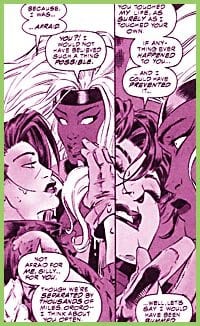When I was eight years old, an amazing store opened right around the corner from my home in Hamilton.
It was called The Comic Connection, and inside was a treasure chest of fantastic stories: tales of hunky super-powered men in tights and strong beautiful women who fought for good and justice.
As a young boy who felt different for reasons which I could not yet understand, comic books were a place to escape, a place where I could have a secret identity, where I, Clark Kent, could become Superman for a few hours each day.
DC Comics were popular with my friends at school, but I knew right away that I was a Marvel boy.
The Marvel Comics universe was different from DC Comics in some key ways. First, whereas DC Comics heroes such as Superman and Batman lived in imaginary cities like Metropolis and Gotham, respectively; the Marvel heroes lived in real places like New York City and Washington, DC. Furthermore, DC Comics focussed on heroes who were literally super men and women. They were gods like Wonder Woman or invulnerable aliens like Superman, sworn to protect lesser mortals from harm.
In the Marvel Universe, however, heroes were super powered, but as flawed as you or me. Spiderman was a gawky nerd by day, struggling to make ends meet. Daredevil was a crime-fighting acrobat by night, but alter-ego Matt Murdoch was a blind man. When not wearing his high-tech metal suit, Iron Man Tony Stark was confined to a wheelchair.
And then there were the X-Men.
The X-Men told the story of a team of outlaw heroes gathered together by Professor Charles Xavier, a wheelchair-bound mutant telepath. Xavier saw that humanity was undergoing the next step in its evolution. Boys and girls across the world were developing strange powers when they hit puberty, powers which frightened humans around them. He formed the X-Men to teach these young mutants to control their powers.
The X-Men fought for truth and justice in a world that feared and hated them. Other heroes like Superman or Spiderman were adored by their public, whereas the X-Men were branded as dangerous freaks, and hunted by their own government.
As a gay kid, struggling to understand the mysterious feelings erupting inside me, I could easily relate to the atmosphere of fear and prejudice which coloured the X-Men books. These heroes were forced to live closeted lives. Many were rejected by their families and were filled with self-loathing. As subtext, the parallels between life as a young mutant and life as a young homo were rich indeed.
There were other clues that the X-Men were a little queer. Some mutants suffered from the Legacy Virus, a disease which afflicted only mutants. The Legacy virus caused some mutants to gradually waste away, and finally to be consumed by their own powers. The disease soon became yet another reason for the outside world to fear the “mutant menace.”
A young Canadian mutant called Northstar actually came out in the comic as a gay man in the early ’90s. Northstar was a character spun out of the X-Men into the pages of Alpha Flight, a Canadian super team.
While Northstar’s revelation makes him the only “out” mutant on record, there have been plenty of hints to suggest other gay romances over the years. Storm has always been my favourite X-Man. She is a regal African woman with white hair and eyes, with the ability to manipulate the weather. Storm is worshipped as a goddess by her tribe because she could ride the winds and make the rain fall, preventing famine and drought.
The weather is so tied to her mood that she has to maintain an untouchable distance from those around her, for fear of unleashing a deadly hurricane or tornado.
While in Japan on a mission with the X-Men, Storm became infatuated with a vivacious female ninja named Yukio. Yukio’s thirst for life and sense of adventure would transform Storm forever. They disappeared together for a few days. When Storm reappeared, she had changed dramatically. Her long flowing hair had been cut into a severe white Mohawk; her fine gowns replaced by the tough leather and chains of a punk rocker.
Though a lesbian affair between Storm and Yukio was only hinted at, it was clear that their relationship was more intense than any hurricane Storm could generate. By the mid-’80s, Storm was leading the X-Men – an African woman with a white Mohawk! The X-Men were always ahead of their time….
When I began to read X-Men in 1982, it was an obscure, little-read comic book with a strange premise and some very unusual characters. But for the last decade, The X-Men has been the top-selling comic book in the world. An entire generation of kids has grown up following their adventures as they battle loneliness, bigotry and prejudice. I’d like to think that the world is a better place for it.

 Why you can trust Xtra
Why you can trust Xtra


